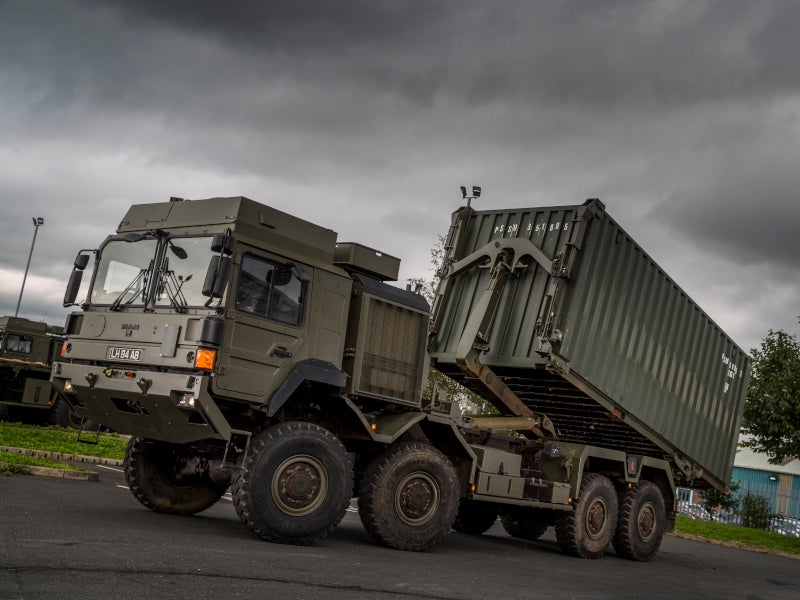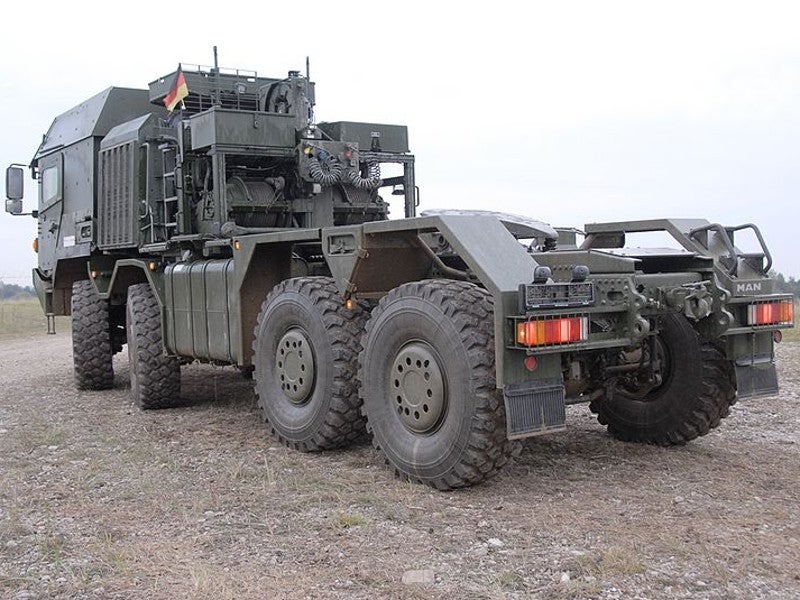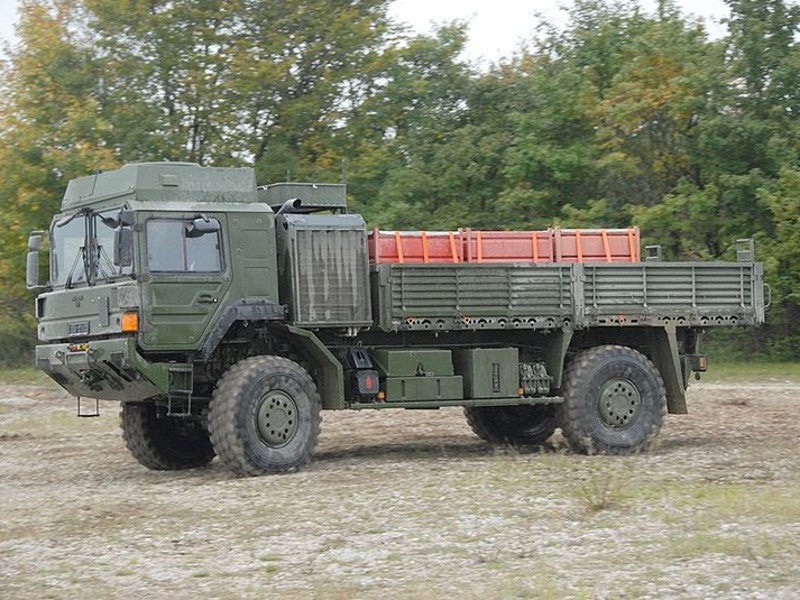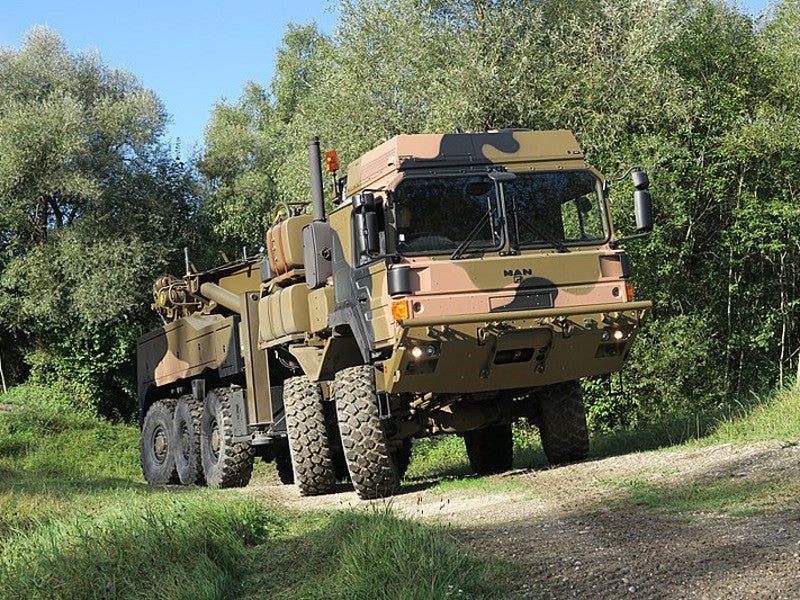The HX family of high mobility logistic trucks is used to carry out tactical and technical missions. The high mobility truck system is part of the Rheinmetall MAN Military Vehicles (RMMV) family, including the HX and SX range of vehicles.
HX series is an advanced version of MAN Truck & Bus’ civilian TGA series. RMMV, the manufacturer of the HX series, is a joint venture of Rheinmetall (51%) and MAN Truck & Bus (49%).
The company’s engineering department, located in Vienna, Austria, modifies the vehicles to meet military requirements. More than 10,000 vehicles of the family are currently in service worldwide.
The HX family is an operationally proven, cost-effective mobility truck system class. HX vehicles integrate military off the shelf (MOTS) components and are designed to support military operations, with the capability to provide high mobility and reliability in difficult terrains.
The military vehicles are based on the proven MAN Trucknology series. The HX 10×10 heavy recovery vehicle was displayed at the CANSEC 2019 exhibition in Ottawa, Canada.
RMMV HX Family orders and deliveries
Rheinmetall secured a €382m ($424.62m) contract from the German Bundeswehr to deliver 1,000 additional HX family trucks in December 2019. The vehicles are expected to be delivered by the end of 2020.
The order was part of a seven-year framework contract signed with the Federal Office for Bundeswehr Equipment, Information Technology and In-Service Support (BAAINBw) in July 2017 for the supply of 2,271 HX vehicles.
Swedish armed forces awarded a contract to Rheinmetall for 40 high-mobility trucks from the HX family in January 2019. The order includes 16 tractor trucks and 24 transport vehicles, with deliveries expected to begin in the first quarter of 2021. The logistic vehicles will be used to transport the Patriot air defence system.
Rheinmetall received a contract to upgrade some of the British Army’s HX trucks in September 2018. The contract requires the supply of 382 Enhanced Pallet Loading System (EPLS) retrofit kits for integration into the vehicles. The retrofitting is expected to be completed by the end of January 2021.
Deliveries of the HX vehicles to the British Armed Forces started in 2007 and more than 7,500 were delivered by 2013. The UK acquired the vehicles to replace the old Leyland and Bedford trucks, and the Foden recovery vehicles. The trucks were deployed in Afghanistan and Iraq to support the army’s operations.
The high mobility truck system was also ordered by countries including Australia, New Zealand, Denmark, and Norway. The first vehicles ordered by Australia as part of the LAND 121 Phase 3B contract for the supply of 2,500 vehicles and 3,000 modules were delivered in April 2016.
HX family design and features
The HX family vehicles feature low-torsion ladder frame, which is derived from the frame of the civilian TG series. The truck has heavy off-road capabilities and the steel bumpers provide greater reliability.
It provides multi-fuel capability, and increased mobility, protection, modularity and interoperability. The components of the different variants in the family are interchangeable. The RMMV HX family has similarities across the versions and offers synergies in training and maintenance due to the commonalities.
The truck is installed with advanced technology when compared to the previous versions and features advanced leaf spring suspension, extreme fording capabilities and multi-fuel engines. The vehicles are capable of operating at temperatures ranging from -32 to +49°C. An arctic kit can be installed to enable operations in climatic conditions with temperatures as low as -6°C.
The modular design of the mobility truck system allows for the integration of protective modules and/or weapon stations to enable self-defence capability. It can also be fitted with a modular armoured cabin (MAC) or an integrated armoured cabin to provide ballistic and mine protection according to STANAG specifications.
The vehicle is available in longitudinal radiator configuration and includes a transversely mounted spare tyre. The engine is mounted under the vehicle’s cab and is capable of meeting high power needs, while the air intake and radiator are present behind the cab. The family includes transport vehicle and heavy-duty transporter versions.
The HX family includes multiple variants designed to serve different purposes, including cargo trucks, tankers, heavy-duty recovery vehicles, firing units, and folding-road and bridge-laying systems. The chassis design facilitates the installation of protected cabins. Additional systems that can be fitted to the vehicle include NBC ventilation system for the protected cabs, links to soldier systems, integrated command and control systems, jammers, smoke dispenser systems, and active defence systems (ADS).
Variants of HX family
RMMV HX family of vehicles is available in several variants, including HX 60 (4×4), HX 58 (6×6), HX 77 and HX 81 (8×8), and HX 10×10. The vehicles can carry cargo/troops with a gross train weight of more than 120t.
The vehicle includes an improved suspension system featuring wear-free, rubber-mounted springs, large shock absorbers and stabilisers.
The 7.44m-long HX 60 is equipped with 6-cylinder MAN D0836 diesel engine with direct fuel injection. The water-cooled engine provides a power output of 240kW. HX 60 can achieve a maximum speed of more than 90 km/h, step climbing ability of 0.5m, and up to 1.2m of fording capability.
It can climb slopes at a gradeability of 60% and cross ditches measuring 1.2m in width. The vehicle has a weight of 18t and can carry 6t of military payload. A variant of HX 60 designed to carry troops has a three-member crew and can accommodate 20 infantrymen. It is installed with fold-down panels at the rear end and to the sides.
Powered by a 6-cylinder MAN D2066 diesel engine with an output of 324kW, HX 58 is a highly mobile transport vehicle. The 8.68m-long vehicle offers increased off-road manoeuvrability and has a maximum speed of over 90km/h. With a torque of 1,250Nm, the 28t platform can accommodate a 6t military payload.
The integrated armour cabin (IAC) of the HX 77 can protect the crew from threats such as landmines, ballistic threats, and improvised explosive devices (IEDs) in compliance with NATO STANAG 4569. The 8×8 class truck measures 10.27m long and can cross 2.5m-wide trenches. It has a permissible weight of 40t and a payload-carrying capability of 16.5t. Its container handling unit (CHU) and hook-lift system allow the vehicle to carry a 20ft container weighing up to 15t.
HX 81 8×8 class includes a MAN D2868 8-cylinder diesel engine that can provide 500kW of power. It can act as a semi-trailer or tank transporter and its off-road mobility is similar to HX 77. With a gross train weight of 130t, the truck provides the capability to transport modern main battle tanks in rough terrain conditions.
HX2 is the latest iteration of the HX series and serves as a protected transport vehicle with the capacity to carry higher axle loads. The hydraulic dual-circuit steering system of the truck helps in distributing the high steering forces over the front axles, allowing precise steering while operating in rugged terrains. Australia is the first recipient of the HX2 variants.
The HX 10×10 heavy recovery vehicle is a highly mobile platform that brings together heavy-duty recovery capability and off-road mobility, with the ability to recover vehicles in both suspended and supported tow mode. It has a crane with recovery capability of 23t, an underlift that can carry up to 15t, two Rotzler HZ090 winches, a Rotzler TR200 main winch, and a recovery boom.







